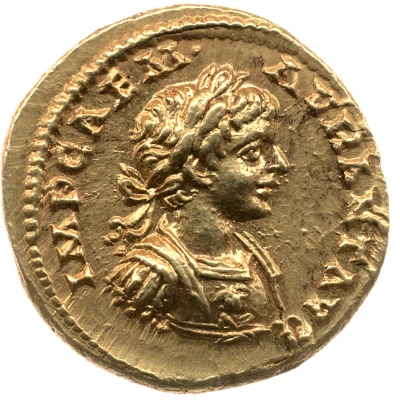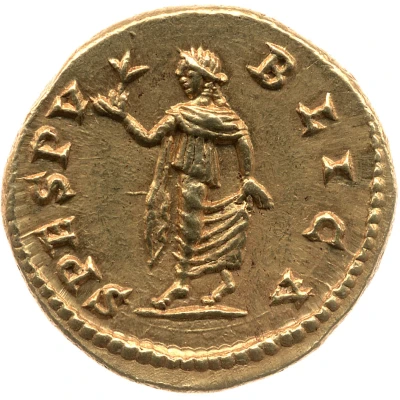Aureus - Caracalla MINER VICTRIX; Minerva and Victory
198 year| Gold | - | - |
| Issuer | Rome › Roman Empire (27 BC - 395 AD) |
|---|---|
| Emperor | Caracalla (Marcus Aurelius Antoninus Caracalla) (198-217) |
| Type | Standard circulation coin |
| Year | 198 |
| Value | 1 Aureus = 25 Denarii |
| Currency | Denarius, Reform of Augustus (27 BC – AD 215) |
| Composition | Gold |
| Shape | Round (irregular) |
| Technique | Hammered |
| Demonetized | Yes |
| Updated | 2024-10-05 |
| Numista | N#273583 |
|---|---|
| Rarity index | 100% |
Reverse
Minerva, helmeted, draped, standing left, holding Victory in extended right hand and spear in left hand; at feet, shield; behind, trophy.
Script: Latin
Lettering: MINER VICTRIX
Translation:
Minerva Victrix.
Minerva, the victorious.
Comment
Source:Online Coins of the Roman Empire (OCRE)
Interesting fact
The Aureus - Caracalla coin was minted during the reign of Emperor Caracalla, who ruled the Roman Empire from 211 to 217 AD. The coin features an image of Minerva, the Roman goddess of wisdom and war, on one side, and Victory on the other. The coin was made of gold, which was a valuable and prestigious metal at the time. Interestingly, the Aureus - Caracalla coin was used as a form of propaganda by the Roman Empire. The image of Minerva and Victory on the coin was meant to convey the idea that the Roman Empire was strong, powerful, and victorious, and that Caracalla was a wise and capable leader. The coin was also used to promote the cult of the Roman emperor, and to reinforce the idea that the emperor was a divine figure, appointed by the gods to rule over the empire. Overall, the Aureus - Caracalla coin is a fascinating piece of history that provides insight into the political and cultural practices of the Roman Empire during the 3rd century AD.

